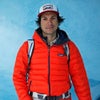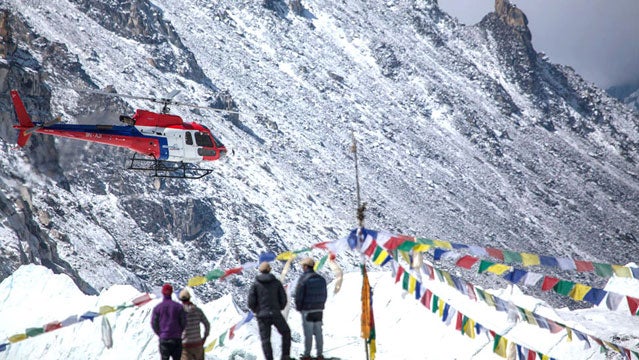This has been one of the driest years anybody can remember on Everest. As a consequence of the drought, snow and ice that usually locks stones into the slopes has melted out, unleashing a torrent of rockfall on Everest’s west shoulder and the Lhotse and Nuptse faces. Lead guide from International Mountain Guides Justin Merle counted between two and 10 rocks per minute falling at the base of the Lhotse Face. The heightened risk of rockfall has caused serious concern among commercial expeditions attempting the South Col route.
 Bare slopes are cause for concern.
Bare slopes are cause for concern.Yesterday, a group of guides from (AAI), Patagonian Brothers Expeditions, and —including AAI’s Lakpa Rita, one of the most respected and experienced Sherpas on the mountain—began putting in an alternate route from Camp II to Camp III to try and offer climbers some protection from the rockfall. The new route swerves south (climber’s right) into a band of seracs and crevasses that should help swallow up some of the rocks coming down from above.
Still, the rockfall has already taken its toll. Earlier this week, American was nearly killed by a suitcase-sized boulder that likely fell from near the summit of Lhotse. “It was going nearly terminal velocity,” says Kellogg, who heard someone shout and then immediately fell prone. “It clipped my backpack and landed just behind my feet.” Dr. Ashish Lohani, of the Himalayan Rescue Association (HRA), commonly known as Everest ER, confirmed that there have been at least five rock strikes in the last week, including two broken arms, two hand injuries, and an Indian man who received a laceration after his helmet was shattered
Then yesterday, there was a more serious incident. A Sherpa named Lhakpa Nuru, 26, who was working for U.K.-based , was struck in the side of the face by a rock, reportedly near Camp III. Another Sherpa helped him walk down to Camp II, where he was met by guide and paramedic Melissa Arnot. (By that point, Summit Climb’s expedition leader Arnold Coster had joined the injured man.) Arnot’s initial assessment indicated signs of traumatic brain injury; the man’s jaw was badly broken, his left eye was damaged, and he was disoriented.
She immediately recommended a helicopter rescue to both the HRA and Coster. But Coster and Summit Climb’s in-country agent, Everest Parivar Expeditions, who Coster reached at the scene via satellite phone, said they had no insurance for such a rescue and couldn’t afford the $5,000. (Coster told Arnot it was $15,000, and a Parivar representative quoted Arnot $5,000.)
“I told him to look me in the eye and tell me this guy’s life isn’t worth $5,000,” says Arnot.
After a 45-minute negotiation, at 5:30 p.m., the HRA finally confirmed that a helicopter was en route from Lukla. Just before dusk, pilot Simone Moro swooped in and made the pickup. Lhakpa spent the night in Lukla and is now receiving treatment in Kathmandu.
“I’m disgusted by people who are climbing Mount Everest but then claim poverty when it comes to properly taking care of their employees,” says longtime RMI guide Dave Hahn. “Doing it responsibly is what makes climbing Everest expensive.”
Multiple attempts were made to reach Summit Climb for comment, but calls have not been returned. Unless the weather changes, rockfall will remain the most pressing concern on the mountain. Today, a Base Camp–wide meeting took place, where expedition leaders discussed the dangers of rockfall and the new route to Camp III. One thing that might lessen the danger is a fresh coat of snow on the mountain. Failing that, more injuries from rockfall are a near certainty.
At least one major outfitter isn’t taking any chances so long as conditions persist. At the meeting, Russell Brice, owner of , told other expedition leaders that current conditions aren’t safe enough for his guides, Sherpas, and clients. Unless conditions improve, he told his colleagues, HimEx is done for the season.
To commemorate the 50th anniversary of the first American ascent of Everest and its then-unclimbed West Ridge, Eddie Bauer has sent a team of seven mountaineers to repeat the historic climbs. �����ԹϺ��� Magazine senior editor Grayson Schaffer is currently embedded with the team at Base Camp, sending back daily dispatches, including stories, photos, and videos. A team sponsored by The North Face and National Geographic is also planning on ascending the notoriously treacherous West Ridge, a route nearly as many climbers have died on as have summitted. Schaffer will be covering both attempts, as well as everything else that happens at Base Camp, until early June.


